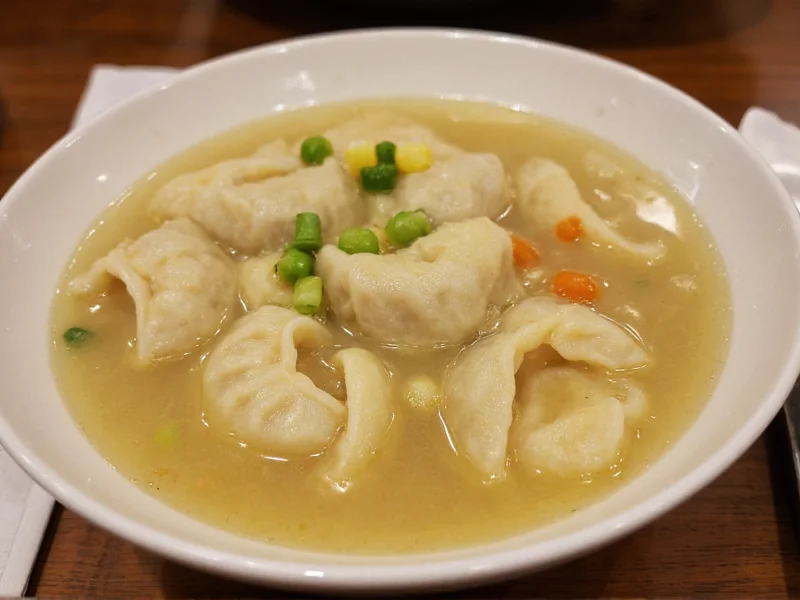Soup dumplings represent one of culinary history's most ingenious innovations—combining solid and liquid elements in a single handheld package. While often associated with Shanghai-style xiaolongbao, variations exist across Asian cuisines, from Japanese shumai with broth pockets to Tibetan thukpa soup dumplings. Understanding their construction reveals why they've captivated food enthusiasts worldwide.
The Science Behind Soup Dumplings
The magic of soup dumplings lies in their aspic-based filling. Chefs prepare a rich meat or seafood stock, then chill it until the collagen solidifies into gelatin. When folded inside the dumpling wrapper and steamed, this aspic melts into a flavorful broth. The key to success is maintaining the proper gelatin-to-liquid ratio—typically 15-20% gelatin by weight—which ensures the broth remains contained until consumption.
Regional Variations Across Cultures
While Shanghai's xiaolongbao remains the most famous iteration, soup dumplings appear in diverse culinary traditions:
| Regional Variation | Distinctive Features | Traditional Serving Method |
|---|---|---|
| Shanghai Xiaolongbao | Thin wheat wrapper, pork filling, crab roe option | Bamboo steamer with ginger threads |
| Tibetan Thukpa | Hand-pulled dough, yak meat filling, clear broth | Directly in hot soup broth |
| Korean Mandu Guk | Thicker wrapper, kimchi-infused filling | Served in hearty beef broth |
| Japanese Nikuman | Fluffy steamed bun, pork broth center | Individual bamboo steamers |
Perfecting Your Soup Dumpling Technique
Creating authentic soup dumplings requires attention to three critical elements:
Wrapper Construction
The ideal wrapper balances thickness and elasticity. Too thin and it tears during handling; too thick and it overwhelms the delicate filling. Professional chefs use a 65% hydration dough (65g water per 100g flour) rolled to 1.5mm thickness at the edges and slightly thicker at the center. The pleating technique—typically 18-24 folds—creates the signature crown while ensuring a secure seal.
Filling Composition
Successful fillings maintain a precise 3:1 meat-to-broth ratio. For homemade aspic, simmer pork hocks, chicken feet, and ginger for 6 hours, then strain and chill overnight. When incorporating into the filling, keep all ingredients cold to prevent premature melting. Seasoning should be subtle—soup dumplings showcase texture and temperature contrast more than aggressive flavors.
Steaming Protocol
Steam soup dumplings over vigorously boiling water for exactly 8-10 minutes. The bamboo steamer should sit 2 inches above the water line, with a tight-fitting lid. Line the steamer with cabbage leaves or parchment paper to prevent sticking. Crucially, allow dumplings to rest for 2 minutes after steaming—this lets the wrapper set and reduces bursting risk when handled.
Troubleshooting Common Issues
Even experienced cooks encounter challenges with soup dumplings. Here's how to address frequent problems:
- Leaking broth: Caused by insufficient pleating or warm filling. Solution: Ensure 18+ pleats and keep filling chilled until wrapping.
- Tough wrappers: Result of overworked dough or improper hydration. Solution: Rest dough 30 minutes before rolling and maintain 65% hydration.
- Dense filling: Occurs when meat isn't finely minced. Solution: Pulse meat in food processor until paste-like consistency.
- Soggy bottoms: Steam condensation dripping onto dumplings. Solution: Tilt steamer lid slightly or line with lettuce leaves.
Serving and Enjoyment Protocol
Traditional soup dumpling etiquette enhances the experience. Place the dumpling in a spoon, add a thread of ginger and drop of black vinegar, then create a small opening in the wrapper to sip the broth before eating. Never bite directly—the hot broth can cause serious burns. For optimal enjoyment, consume within 3 minutes of steaming when the wrapper remains tender but structured.
Modern Interpretations and Innovations
Contemporary chefs have expanded soup dumpling possibilities while respecting tradition. Notable innovations include:
- Vegetarian versions: Using mushroom dashi and agar-based broths
- Global flavor profiles: Truffle-infused xiaolongbao, lobster mandu
- Freeze-friendly formulations: Modified starches that maintain broth integrity after freezing
- Miniature presentations: Bite-sized versions for appetizers
These adaptations demonstrate soup dumplings' versatility while maintaining their essential character—delivering a surprising burst of flavorful broth in every bite. Whether enjoying traditional Shanghainese versions or contemporary interpretations, the core pleasure remains unchanged: that magical moment when solid and liquid unite in perfect harmony.
How do you prevent soup dumplings from bursting during cooking?
Keep the filling thoroughly chilled until wrapping, use at least 18 pleats for secure sealing, and maintain proper aspic ratio (15-20% gelatin). Rest the shaped dumplings in the refrigerator for 15 minutes before steaming to set the wrapper.
Can soup dumplings be made ahead and frozen?
Yes, but with modifications. Freeze shaped dumplings on a parchment-lined tray until solid (2 hours), then transfer to airtight containers. For best results, increase gelatin content by 5% and reduce water in the aspic. Steam frozen dumplings for 12-14 minutes without thawing.
What's the difference between xiaolongbao and regular dumplings?
Xiaolongbao contain a solidified broth (aspic) that melts during steaming, creating a soup-filled interior. Regular dumplings typically have solid fillings only. Xiaolongbao wrappers are thinner (1.5mm vs 2mm) and use a higher hydration dough (65% vs 55%), with distinctive pleated crowns.
Why do my soup dumpling wrappers become soggy?
Sogginess occurs when steam condensation drips onto dumplings. Prevent this by lining the steamer with cabbage leaves, tilting the lid slightly to encourage runoff, or placing a clean kitchen towel between the lid and steamer. Ensure water isn't touching the dumplings and maintain vigorous boiling.
What's the traditional dipping sauce for soup dumplings?
The classic combination is black vinegar (Chinkiang vinegar) with thin ginger threads. Some variations add a drop of sesame oil or a pinch of sugar. The acidity cuts through the richness of the broth while the ginger provides aromatic contrast without overwhelming the delicate flavors.











 浙公网安备
33010002000092号
浙公网安备
33010002000092号 浙B2-20120091-4
浙B2-20120091-4